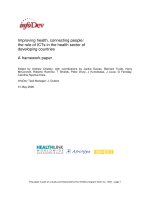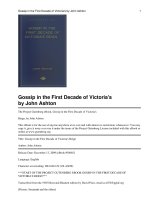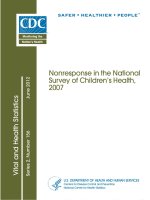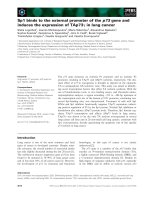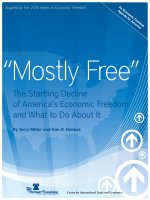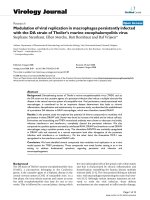The external sector of africa`s economy
Bạn đang xem bản rút gọn của tài liệu. Xem và tải ngay bản đầy đủ của tài liệu tại đây (7.64 MB, 243 trang )
Advances in African Economic,
Social and Political Development
Diery Seck Editor
The External
Sector of
Africa’s
Economy
Advances in African Economic, Social
and Political Development
Series Editors
Diery Seck, CREPOL - Center for Research on Political Economy, Dakar, Senegal
Juliet U. Elu, Morehouse College, Atlanta, GA, USA
Yaw Nyarko, New York University, NY, USA
Africa is emerging as a rapidly growing region, still facing major challenges, but
with a potential for significant progress – a transformation that necessitates vigorous
efforts in research and policy thinking. This book series focuses on three intricately
related key aspects of modern-day Africa: economic, social and political
development. Making use of recent theoretical and empirical advances, the series
aims to provide fresh answers to Africa’s development challenges. All the sociopolitical dimensions of today’s Africa are incorporated as they unfold and new
policy options are presented. The series aims to provide a broad and interactive
forum of science at work for policymaking and to bring together African and
international researchers and experts. The series welcomes monographs and
contributed volumes for an academic and professional audience, as well as tightly
edited conference proceedings. Relevant topics include, but are not limited to,
economic policy and trade, regional integration, labor market policies, demographic
development, social issues, political economy and political systems, and
environmental and energy issues.
More information about this series at />
Diery Seck
Editor
The External Sector
of Africa’s Economy
Editor
Diery Seck
CREPOL - Center for Research on Political Economy
Dakar, Senegal
ISSN 2198-7262
ISSN 2198-7270 (electronic)
Advances in African Economic, Social and Political Development
ISBN 978-3-319-97912-0
ISBN 978-3-319-97913-7 (eBook)
/>Library of Congress Control Number: 2019930702
© Springer Nature Switzerland AG 2019
This work is subject to copyright. All rights are reserved by the Publisher, whether the whole or part of the
material is concerned, specifically the rights of translation, reprinting, reuse of illustrations, recitation,
broadcasting, reproduction on microfilms or in any other physical way, and transmission or information
storage and retrieval, electronic adaptation, computer software, or by similar or dissimilar methodology
now known or hereafter developed.
The use of general descriptive names, registered names, trademarks, service marks, etc. in this publication
does not imply, even in the absence of a specific statement, that such names are exempt from the relevant
protective laws and regulations and therefore free for general use.
The publisher, the authors and the editors are safe to assume that the advice and information in this
book are believed to be true and accurate at the date of publication. Neither the publisher nor the authors or
the editors give a warranty, express or implied, with respect to the material contained herein or for any
errors or omissions that may have been made. The publisher remains neutral with regard to jurisdictional
claims in published maps and institutional affiliations.
This Springer imprint is published by the registered company Springer Nature Switzerland AG
The registered company address is: Gewerbestrasse 11, 6330 Cham, Switzerland
Introduction
There is a striking contrast between the attention given by African policymakers and
private sector actors to the external sector of their economies and the limited volume
and scope of the existing literature, in comparison to other development-related
issues. This observation serves to justify this book and the detailed studies that it
includes. From the perspective of the book, external sector is viewed from two
angles. At the national level, it refers to the extent to which individual countries
manage the degree of openness of their economies with respect to trade, foreign
direct investment (FDI), and international financial flows all of which translate into
their participation in globalization. External sector also encapsulates the cross-border
arrangements such as regional integration or various forms of policy harmonization
like common external tariffs. The main underlying motives for increased interest in
the external sector can be listed as follows. First, after more than half a century of
efforts, African countries have failed to achieve their goals in domestic resource
mobilization and have felt the need to look beyond their borders to finance their
development.
Second, inward-looking economic policies of the 1960s and 1970s epitomized by
rhetoric such as infant industry arguments or transfer of economic surplus from the
agricultural sector to industry have not borne fruit. Third, the growing wave of
globalization that swept the world, developed and underdeveloped, and the influence
of multinational companies on the world scene have exposed African countries alike,
in some instances against their will, to a higher degree of presence of their external
sector than during earlier periods. The advent of globalization has also revealed the
need to compete internationally, thus to focus on their comparative advantage, create
sub-regional groupings and promote export-led growth strategies. Over the last three
decades, several elements of evolution in the world economy have put the external
sector in the forefront. They include inception of the World Trade Organization
(WTO), advent of several external debt crises and programs to remedy them,
economic partnerships between Africa and other world regions and the strong
realization that African countries are too small and that sub-regional groupings
might help improve their economic prospects. Yet, despite the failure of African
v
vi
Introduction
countries to industrialize in particular, and to converge towards industrialized
countries, new opportunities such as information and communication technologies
(ICTs) give new impetus to the Continent’s economic fate.
In light of the evolution described above, new questions are raised with respect to
Africa’s external sector and require new answers. In this respect, the stakes underlying external sector policies in Sub-Saharan Africa (SSA) can be summarized by
three policy targets. First, how to secure high and steady access to development
finance through debt flows and FDI? Second, how to achieve a higher level of
international trade and gain more international market share? Third, how to create
larger domestic markets through regional integration arrangements on the
Continent?
The book examines three aspects of the external sector, namely Regional Integration, External Trade, and Macroeconomics and Political Economy.
In the first chapter, Seck assumes that economic welfare is pursued by an African
country considering or evaluating its Regional Integration Arrangement (RIA)
membership. He proposes an approach that assigns to inputted residuals computed
from pre-integration trend lines the change in after-reform per-capita GDP and gives
an estimate of the economic gain that arises from the integration initiative for each
member country. The timing of the gain is also identified starting from the year of
integration enactment. For the sampling period 1970–2016, the results show that
members of the UEMOA benefitted significantly and rapidly from the reform of
1994 while CEMAC countries reaped a significantly lesser gain. Considerable gains
also accrued to EAC members over the period 1978–2016.
In the second chapter, Chuku Chuku et al. seek to understand three main issues:
first, what are the long- and short-run determinants of current account balances in
West Africa; second, is there a sustainable path for the current account position that
is consistent with regional integration; and if so, what has been the process of
adjustment towards such a path. They address these questions by first identifying
the long-term determinants of the current account, and then using the results to
calculate the equilibrium sustainable targets for the current account in the region.
After accounting for short-run disequilibrium adjustment processes, they show how
far apart each country is from the regionally sustainable path. Their key findings are
as follows: the determinants of current account dynamics differ depending on the
time horizon; the real exchange rate, fiscal policy, trade openness, investment, and
income levels are the key determinants in the short run; there is considerable
variation by country in the deviation of each country’s current account position
from the regionally sustainable equilibrium path.
Doukoure analyzes in chapter “Obstacles to Strengthening Economic Integration
in the West African Economic and Monetary Union” the obstacles to strengthening
economic integration in the West African Economic and Monetary Union
(WAEMU). Several studies show that strengthening economic integration requires
an increase of intra-trade in Regional Trade Agreements (RTAs). But it is not the
case in WAEMU where trade between member countries is rather low. He seeks to
identify both the economic and political factors that limit economic integration in
WAEMU and how they impact trade between members. In order to rank such
Introduction
vii
potential obstacles, he develops an extended gravity model, using a panel dataset for
WAEMU from 1996 to 2013 for all member countries. Bilateral export flows
between member countries are used as endogenous variables.
In addition to the usual variables (income, population size, and distance), the
effects of three factors (infrastructure, economic policy, and political tensions) are
taken into account. The empirical results show that the state of infrastructure gaps—
in particular, telecommunications and transport networks slow down significantly
economic integration within WAEMU.
External trade is also investigated as a prime component of the external sector of
African countries. In chapter “Growing External Trade, Development and Structural
Heterogeneity in West Africa: Examining the Evidence”, Ekpo and Omotor’s study
sets out to determine the extent to which West African economies are integrated and
assess their take in the global value chains and some important parameters which
could influence their trade flows given the perceived structural heterogeneity among
them. The findings and results from the West African Enabling Trade Index, their
participation in Global Value Chains and estimated simple gravity model among
others suggest that trade performance of the sub-region does not sufficiently improve
its export performance. Second, access to trade finance and identifying potential
markets and buyers are among the most problematic factors that inhibit export trade
in the region. The implication is that reducing these barriers will enable trade and
contribute to prosperity and welfare.
In chapter “Driving Factors of Intra-regional Trade in Agricultural Goods: The
Case of West African Economic and Monetary Union”, Houeninvo et al. examine
the impact of distance (transport/logistical cost) and the level of development on
intra-WAEMU agricultural exports. They analyze the determinants of intraWAEMU trade in agricultural products and therefore the variables on which
policymakers could act to promote intra-regional trade. Using a panel data estimation in a gravity model over the period 1996–2013 covering seven West African
countries with yearly data, they show that two gravity factors, the level of development measured by GDP as well as the distance are highly significant at 1% with the
expected signs. Regarding the four control variables population (pop), foreign direct
investment (FDI), political stability, and the common external tariff, all of them have
the expected signs but only FDI with 2 lags is significant, at 1%.
In chapter “Trade Openness and Food Security in Africa: A Comparative Study
of CEMAC and WAEMU Countries”, Assoumou Ella and Eba Nguema conduct a
comparative analysis of the effect of trade liberalization on food security in EMCCA
and WAEMU countries with data spanning the period 1987–2014. Their findings
lead to the conclusion of a negative effect in general. The beneficial effect of trade on
the food situation is most visible in terms of availability. Also, it leads to lower
prices. However, adverse terms of trade appear to wipe off the positive effects and
lead to food insecurity. This outcome is robust for both the EMCCA and WAEMU
samples. With regard to policy, these countries should implement trade policies to
facilitate openness, while supporting and diversifying domestic food production.
Okah Efogo in chapter “Trade in Services for Growth and Structural Transformation in West Africa” seeks to identify the categories of services likely to foster
viii
Introduction
structural transformation and economic growth in ECOWAS. With data on
ECOWAS countries over the period 1995–2015, she estimates a dynamic panel
model and shows that for each ECOWAS county there is at least one category of
services that promotes structural transformation and/or economic growth. Services
trade (imports and/or exports) could be a powerful tool for economic growth,
structural transformation, and integration if the various countries rely on the appropriate service for this purpose.
Macroeconomics and political economy issues are studied in three chapters. In
chapter “Macroeconomic Effects of Commodity Price Shocks in ECOWAS Members”, Tule et al. examine the effect of commodity price shocks on ECOWAS
member countries using a panel data analysis of 13 member countries for the period
2000–2015. Dynamic General Method of Moments (GMM) technique was adopted
using an instrumental variable (IV) regression model. Their results show that
precious metals are positively but insignificantly related to gross domestic product
per capita. Also, there is a positive and statistically significant relationship between
energy prices and the dependent variable. However, a negative relationship is
observed between non-energy prices and gross domestic product per capita. In
addition, the results show that 87% of the economy is susceptible to energy price
shocks. This result forces a rethink of the integration agenda not only along
monetary lines, but also along diversification integration.
In chapter “Is Currency Devaluation Appropriate for Improving Trade Balance in
the Wamz Countries?”, Englama et al. examine the appropriateness of devaluation in
improving trade balance in the six West African Monetary Zone (WAMZ) countries.
The motivation is largely derived from the need to reverse the deteriorating external
sector of these countries which has become worrisome particularly from the latter
half of 2014 on the backlash of a slump in commodity prices and tight global
monetary condition. The study employs descriptive analysis, granger causality
technique, and Vector Error Correction Model (VECM) to analyze the impact of
devaluation on trade balance in these countries. Two other control variables, domestic and global output, are included in the model to capture the impact of domestic and
global shock while the data covers the period 1980–2014. The trend analysis reveals
considerable volatility in real exchange rate in all the countries with the exception of
the Gambia while there is a virtual absence of co-movement between devaluation
and trade balance in all the countries. All the series are integrated to the first order
while Johansen cointegration test indicates the existence of long run relationship
among the variables employed in the study.
Results of the normalized long run model indicate that the coefficient of real
exchange rate is positively significant for only Liberia while it is negatively significant in the Gambia only. Real exchange rate is not significant in the remaining four
countries, suggesting that devaluation may not lead to an improvement in trade
balance in the WAMZ countries except probably in Liberia. Results from the models
further suggest that external conditions like expansion in global output tend to have a
positive impact on trade balance though the effect is not significant in all the
countries. The variables are virtually not significant in the short-run models for all
the countries while the vector error correction term suggests that the impact of shock
Introduction
ix
on trade balance does not wane rapidly. The study recommends, among others, that
devaluation may not be the most appropriate policy option to improve trade balance
in these countries while these economies should endeavor as much as possible to
improve the export content of gross domestic product in order to allow local
economic conditions to drive trade balance.
In chapter “The ECOWAS–EU Economic Partnership Agreement: Towards
Inclusive Development?”, Acheampong and Ortsin analyze the ECOWAS-EU
EPA agreement attempting to answer the question: how does the agreement foster
both international trade and inclusive development by promoting investment and
sustainable growth? Using evidence from countries in the ECOWAS sub-region, this
discussion paper covers the following thematic areas: (1) external sector development impact of the EPA agreement and (2) the impact on fostering inclusive growth
and development. Their results indicate that the EPAs will pose a number of policy
challenges for West African countries as their economies increasingly integrate into
the global economy. However, the EPA provides an opportunity to fast-track global
trade and the regional integration agenda in West Africa. It is important that the EU
treats the EPA as an instrument of development cooperation and not a conduit to
pursue mercantilist corporate interests as did happen in colonial times. They also find
out that balanced growth and poverty reduction are not automatic outcomes from
liberalization processes, but rather these objectives must be actively promoted by
complementary policies in conjunction with appropriate fiscal adjustments in order
to fully gain from trade liberalization.
While the ten chapters of the book cover a broad area of the external sector in the
context of SSA, it leaves unaddressed a number of key issues whose elucidation
would facilitate better understanding of the challenges faced by the sub-region. First,
how do external sector policies, even the most appropriate, cause economic growth
and, for each individual country, which specific external sector policy would yield
the best results? Second, the degree of control of countries over external sector
interventions needs to be ascertained. In other words, to what extent can a country
unilaterally set the level of, say, its export earnings, inbound FDI, or even external
indebtedness from private sources which constitute the largest sources of debt
markets in the world? There is no doubt that the external sector of SSA could
contribute significantly to its economic growth but the right mix of policies to
achieve that goal requires considerable more work.
Dakar, Senegal
June, 2018
Diery Seck
Contents
Part I
Introduction Regional Integration
The Economic Value of Regional Integration in Africa . . . . . . . . . . . . . .
Diery Seck
Current Account Im(balances) and Adjustments to Targets for Regional
Integration in West Africa: One Step Forward, Two Steps
Backwards . . . . . . . . . . . . . . . . . . . . . . . . . . . . . . . . . . . . . . . . . . . . . . .
Chuku Chuku, Johnson Atan, Felix Obioesio and Kenneth Onye
Obstacles to Strengthening Economic Integration in the West African
Economic and Monetary Union . . . . . . . . . . . . . . . . . . . . . . . . . . . . . . .
Doukouré Charles FE
Part II
3
21
51
External Trade
Growing External Trade, Development and Structural Heterogeneity in
West Africa: Examining the Evidence . . . . . . . . . . . . . . . . . . . . . . . . . .
Akpan H. Ekpo and Douglason G. Omotor
75
Driving Factors of Intra-regional Trade in Agricultural Goods: The Case
of West African Economic and Monetary Union . . . . . . . . . . . . . . . . . .
Toussaint Houeninvo and Philippe Sèdédji
95
Trade Openness and Food Security in Africa: A Comparative Study
of CEMAC and WAEMU Countries . . . . . . . . . . . . . . . . . . . . . . . . . . . 119
Giscard Assoumou-Ella and Ismaelline Eba-Nguema
Trade in Services for Growth and Structural Transformation in West
Africa . . . . . . . . . . . . . . . . . . . . . . . . . . . . . . . . . . . . . . . . . . . . . . . . . . . 137
Françoise Okah Efogo
xi
xii
Part III
Contents
Macroeconomics and Political Economy
Macroeconomic Effects of Commodity Price Shocks on ECOWAS
Members . . . . . . . . . . . . . . . . . . . . . . . . . . . . . . . . . . . . . . . . . . . . . . . . 163
Moses K. Tule, Udoma J. Afangideh, Adegoke I. Adeleke,
and Augustine Ujunwa
Is Currency Devaluation Appropriate for Improving Trade Balance in
the WAMZ Countries? . . . . . . . . . . . . . . . . . . . . . . . . . . . . . . . . . . . . . . 185
Abwaku Englama, Momodou Sissoho, Olukayode Odeniran
and Ozolina Haffner
The ECOWAS–EU Economic Partnership Agreement: Towards
Inclusive Development? . . . . . . . . . . . . . . . . . . . . . . . . . . . . . . . . . . . . . 213
Theophilus Acheampong and Ernest Amoabeng Ortsin
Part I
Introduction Regional Integration
The Economic Value of Regional
Integration in Africa
Diery Seck
Contents
1 Introduction . . . . . . . . . . . . . . . . . . . . . . . . . . . . . . . . . . . . . . . . . . . . . . . . . . . . . . . . . . . . . . . . . . . . . . . . . . . . . . . . . . . 4
2 The Theoretical Model . . . . . . . . . . . . . . . . . . . . . . . . . . . . . . . . . . . . . . . . . . . . . . . . . . . . . . . . . . . . . . . . . . . . . . . . 4
3 Case of African Country: Small Economy and Fixed Prices . . . . . . . . . . . . . . . . . . . . . . . . . . . . . . . . 6
4 The Empirical Evidence . . . . . . . . . . . . . . . . . . . . . . . . . . . . . . . . . . . . . . . . . . . . . . . . . . . . . . . . . . . . . . . . . . . . . . 6
5 Existence and Size of the Economic Gain . . . . . . . . . . . . . . . . . . . . . . . . . . . . . . . . . . . . . . . . . . . . . . . . . . . 7
6 Speed of the Economic Gain from Regional Integration . . . . . . . . . . . . . . . . . . . . . . . . . . . . . . . . . . . . 9
7 Conclusion . . . . . . . . . . . . . . . . . . . . . . . . . . . . . . . . . . . . . . . . . . . . . . . . . . . . . . . . . . . . . . . . . . . . . . . . . . . . . . . . . . . . 17
References . . . . . . . . . . . . . . . . . . . . . . . . . . . . . . . . . . . . . . . . . . . . . . . . . . . . . . . . . . . . . . . . . . . . . . . . . . . . . . . . . . . . . . . . . 18
Abstract Economic welfare is assumed to be pursued by an African country
considering or evaluating its Regional Integration Arrangement (RIA) membership.
The proposed approach assigns to imputed residuals computed from pre-integration
trend lines the change in after reform per-capita GDP and gives an estimate of the
economic gain that arises from the integration initiative for each member country.
The timing of the gain is also identified starting from the year of integration
enactment. For the sampling period 1970–2016, the results show that members of
the UEMOA benefitted significantly and rapidly from the reform of 1994 while
CEMAC countries reaped a significantly lesser gain. Considerable gains also
accrued to EAC members over the period 1978–2016.
D. Seck (*)
CREPOL – Center for Research on Political Economy, Dakar Yoff, Senegal
e-mail:
© Springer Nature Switzerland AG 2019
D. Seck (ed.), The External Sector of Africa’s Economy, Advances in African
Economic, Social and Political Development,
/>
3
4
D. Seck
1 Introduction
Membership in regional integration arrangements (RIA) is a widespread strategy of
African countries that has grown in importance over the last 25 years. The main
African RIAs can be categorized as follows: 1) Customs and monetary unions:
Union Economique et monétaire Ouest Africaine (UEMOA), Communauté
économique et monétaire de l’Afrique Centrale (CEMAC), 2) Customs unions:
East African Community (EAC), 3) Multilateral Free Trade Areas: Southern Africa
Development Community (SADC), Arab Maghreb Union (AMU), Common Market
for Eastern and Southern Africa (COMESA), Community of Sahel-Saharan States
(CEN-SAD), 4) Developmental: Economic Community of West African States
(ECOWAS), Communauté Economique des Etats d’Afrique Centrale (CEEAC)
and Intergovernmental Authority for Development (IGAD). Every single country
on the continent is a member of one or more RIAs.
The diversity of goals pursued by the various RIAs may help explain the
multiplicity of national memberships, which raises the question on the motives for
African countries to enter into specific regional integration initiatives. One of the
issues that arises from this situation is to investigate the form of RIA that is most
beneficial in the African context. A common yardstick is needed to assess the value
of each form of RIA for the countries not only as an ex-ante decision tool, given the
possibility to choose to join one form or another, but also to evaluate the welfare
outcome of membership over time.1 The approach to evaluation of the benefits of
RIA membership that is used in this paper does not take into account non-economic
motives such as defense or political considerations, which, arguably, may not be
shared by many countries and therefore serve as common assessment tools. Consequently, economic welfare is the only goal that is assumed to be pursued by an
African country considering or evaluating its RIA membership.2
2 The Theoretical Model
Assessment of the economic gain that accrues from regional integration is based on
the theoretical model proposed by Baldwin and Venables (1995). The gain measures
welfare by the level of consumption.
1
There is debate regarding multiple membership of many African countries in more than one RIA,
the African Union seeking rationalization through single membership while countries adhere to the
policy of multiple membership. So far, no argumentation for or against has prevailed.
2
There is an abundant literature on regional integration. Brenton and Hoffman (2016), Afessorgbor
(2017), Draper (2010), Kritzinger-van Niekerk (undated), the East African Community (2002), the
Economic Commission for Africa (2004), Lindberg and Scheingold (1971) Schiff and Winters
(2003), Teunissen (1996), Volz (2011), and the World Bank examine the nature and process of
regional integration. The gains from regional integration are evaluated by Fernandez (1997),
Lloyd and Maclaren (1996), Mistry (1996, 2000), Mwasha (2008), and Yang and Gupta (1995).
The Economic Value of Regional Integration in Africa
5
Suppose the welfare of a representative consumer is formulated by the following
indirect utility function:
Vðp þ t; n; EÞ
p ¼ vector of border prices
t ¼ vector of trade costs including the tariff equivalent of import barriers
n ¼ vector of the number of product varieties available in each industry
E ¼ Total spending on consumption
Considering that, as an accounting identity, the total of sources of income is equal
to the total of applications of income (consumption and investment), consumption is
equal to total income minus investment:
E ¼ wL þ rK þ X½ðp þ tÞ À aðw; r; xÞ þ αtm À I
ð1Þ
Where,
L ¼ supply of labour, K ¼ supply of capital
r and w are factor prices for capital and labor respectively
X ¼ production vector
a(w,r,x) ¼ average cost that reflects the average cost and the production level in each
sector
α ¼ diagonal matrix that captures the wedge t that creates income for domestic
agents given that α ¼ 1 for a tariff or other barrier that generates domestic rent
income, or α ¼ 0 where there is no rent.
m ¼ net imports
I ¼ investment.
The different components of total income are:
wL + rK is total factor income, wL is labor income and rK is capital income
X[(p + t) À a(w,r,x)] is the level of profit in the economy
αtm ¼ income accruing from import rent.
Totally differentiating the indirect utility function and dividing it by the marginal
utility of expenditure gives:
dV=VE ¼ αt dm À m d½t À αt À m dp
þ½p þ t À a dX À Xax dx þ ðVn =VE Þ dn þ ðR=ρ À 1Þ dI
ð2Þ
In cases of increasing returns to scale and imperfect competition
• [p + t À a] dX: is the output effect
• Xax dx: is the scale effect resulting from changes in average costs as firm scale
changes
• (Vn/VE) dn: is the variety effect, i.e. happens when the number of differentiated
consumer products changes
6
D. Seck
• (R/ρ À 1) dI: is the profitability of investment where R is the social rate of return,
ρ is the social discount rate so,
If R > ρ then a positive change in investment will result in higher profits.
3 Case of African Country: Small Economy and Fixed
Prices
African countries have small economies and do not enjoy a high degree of international competitiveness. They also trade very little with each other. As a result, most
RIAs that they enter into seek to increase their intra-regional trade, some form of
protection through high external tariff and other external trade barriers. Given their
limited influence on international markets, they are price takers and face fixed prices.
In other words, the following conditions apply to them: α ¼ 1, t À αt ¼ 0 and dp ¼ 0
Given these three conditions, Eq. (2) reduces to
dV=VE ¼ αt dm
þ½p þ t À a dX À Xax dx þ ðVn =VE Þ dn þ ðR=ρ À 1Þ dI
ð3Þ
The analysis below focuses on the welfare effect caused by changes in the factors
that can result from the RIA, namely increase in imports (dm), increase in production
(dX), increase in investment (dI), increase in number of sectors (dx) and increase in
number of consumer products (dn). If there is economic value in regional integration, it will materialize through one or more of them.
Based on the model the conditions for positive economic value of regional
integration are: dm > 0, dX > 0, dI > 0, dn > 0 and dx < 0.
4 The Empirical Evidence
Empirical assessment of the economic value of regional integration is conducted at
the level of individual countries considering that they decide to enter or leave a RIA.
Given the relatively large number of RIAs in Africa and the need to measure as
accurately as possible their impact through stronger attribution of the endogenous
economic variables, the cases of advanced integration are examined. In this regard,
the analysis will focus on the UEMOA and CEMAC, which are customs and
monetary unions, and the EAC, a customs union. The analysis will use a beforeafter approach which consists in comparing the levels of the endogenous variables
during the years before the year of inception of the RIA and the years after its
creation. Welfare is measured by Per Capita Growth Domestic Product (GDP).
Considering that economic variables may change irrespective of the RIA status of
the country, the residual imputation approach is used. It consists in estimating the
The Economic Value of Regional Integration in Africa
7
trend of the endogenous variables for the period preceding inception of the RIA and
comparing their actual values with the values that are obtained if the pre-RIA trend is
extended.
The residuals that are calculated, difference between actual and trended values are
considered to be the impact of the RIA; Clavaux (1969), Truman (1969). The
underlying rationale is that the residuals are fully attributed to the impact of the
RIA although, in reality other factors including shocks, may also be at play.
Econometric techniques are proposed in the literature to address this issue but
require considerable data that are not available for most African countries. As a
result, the residual imputation approach is utilized in the present study despite the
criticism that is leveled at it.3
In order to conduct the empirical inquiry two questions are investigated. The first
one is whether there is an economic gain that arises from the RIA and its size. The
second question addresses the speed of accrual of the gain that follows inception of
the RIA.
5 Existence and Size of the Economic Gain
The measure of economic welfare that is most common in developing economies is
the Per Capita GDP. Statistical data related to it are readily available from a number
of sources in a standardized form. Therefore, the Per Capita GDP in constant 2010
Dollars published by the World Bank’s World Development Indicators (WDI) is
used in this study. As stated earlier, African countries with the most advanced
agenda for regional integration are included in the sample. Specifically, they cover
UEMOA countries: Benin, Burkina Faso, Côte d’Ivoire, Guinea Bissau, Mali, Niger,
Senegal and Togo; CEMAC countries: Cameroon, Central African Republic, Chad,
Republic of Congo, Equatorial Guinea and Gabon; and East African Community
(EAC): Burundi, Kenya, Rwanda and Uganda. Tanzania has been left out for lack
of data.
The technique of residual imputation is used to measure the economic gain. The
Per Capita GDP trend line is computed for the years prior to the inception of the RIA.
The trend equation is used to extend the trend over the RIA years thus giving
projected value of the Per Capita GDP. The difference between the actual value of
the Per Capita GDP and the projected value gives the imputed residual for each year
in the RIA period. The rationale is that gain from RIA is attributed to the imputed
residual. It is noteworthy that, at the single country level, other factors such as policy
changes or shocks that are independent from regional integration could affect Per
Capita GDP. However, imputed residuals can be a convenient way of assessing the
3
Alternative econometric techniques are proposed by Aitken and Lowry (1973), Balassa (1974),
Resnick and Truman (1973), Winters (1984), Coe and Moghadam (1993), Carrere (2004), Tegoum
et al. (2013), Afesorgbor (2017).
8
D. Seck
economic value of regional integration if there is congruence between different
countries of the same integrated zone.
Table 1 presents the results of the calculation of economic gains accruing to the
member countries based on the imputed residuals. For the UEMOA the mean
imputed residual, calculated over the RIA period, 1994–2016, shows a strongly
significant economic gain for all the countries except for Guinea Bissau that experienced a civil war in 1998 and 1999, immediately after it became a member of
UEMOA in 1997. CEMAC fared more modestly with three of the six sampled
countries showing a significant gain while three others had negative mean imputed
residuals. The countries, Cameroon, Congo and Gabon, have the three largest
economies. This is puzzling unless one considers that the adjustment sought with
Table 1 Statistics of the mean imputed residuals
Mean imputed
Standard
residual
error
t Value Signif.
Union economique et monétaire de Ouest Africaine (UEMOA)
Benin
75.52
5.72
13.20 ***
Burkina Faso
93.65
14.27
6.56 ***
Côte d’Ivoire
324.45
55.64
5.83 ***
Guinea Bissau
À176.04
14.42
À12.21
Mali
51.49
8.20
6.28 ***
Niger
115.94
17.06
6.79 ***
Senegal
173.35
26.67
6.50 ***
Togo
45.00
10.01
4.50 ***
Communauté economique et monétaire de l’Afrique Centrale (CEMAC)
Cameroon
À591.64
13.31
À44.44
Central African
65.47
11.75
5.57 ***
Rep.
Chad
258.98
44.66
5.80 ***
Congo, Republic À1230.56
49.25
À24.99
Equatorial
10,944.62
1367.69
8.00 ***
Guinea
Gabon
À1758.36
208.79
À8.42
East African Community (EAC)
Burundi
0.103
0.017
6.06 ***
Kenya
83.469
26.206
3.19 ***
Rwanda
263.12
27.95
9.41 ***
Uganda
102.07
13.13
7.77 ***
Ratio mean
imputed
residuals/actual
values
0.099
0.168
0.246
À0.331
0.091
0.327
0.175
0.086
À0.508
0.157
0.308
À0.482
0.862
À0.188
0.103
0.078
0.421
0.175
Note: Confidence levels are 99% (***) and 95% (**). Sampling periods are 1970–2016 for
UEMOA and CEMAC countries and 1978–2016 for EAC countries except for Equatorial Guinea,
1980–2016 and Uganda 1982–2016. RIA periods are 1994–2016 for UEMOA and CEMAC and
2000–2016 for EAC. However, for Guinea Bissau the RIA period is 1997–2016. For Rwanda and
Burundi it is 2007–2016
The Economic Value of Regional Integration in Africa
9
the reform underlying the RIA initiative was adequate for UEMOA countries than
for CEMAC countries.
An alternative explanation could be that the economies of Cameroon, Congo and
Gabon were close to their full GDP potential prior to the RIA and that after inception
of the reform its costs were higher for them than its benefits. It is worth noting that
Equatorial Guinea has scored a very large mean imputed residual during the RIA
period, most likely owing to the very high increase in revenues from oil, its main
export commodity. The East African Community has recorded results similar to
UEMOA’s because all four countries (Tanzania being excluded) display positive and
significant mean imputed residuals.
The last column of Table 1 reports the size of the economic gain of the RIA
accruing to each country. The mean Ratio of imputed residuals over Actual Values
of Per Capita GDP provides the proportion of the Actual Per Capita GDP that is
contributed by the RIA. In the case of UEMOA, the RIA contributed sizable shares
of the Per Capita GDP, especially for Niger: 32.7%, Côte d’Ivoire: 24.6%, Senegal:
17.5% and Burkina Faso: 16.8%. As for Guinea Bissau, it lost one third (À33.1%) of
its Per Capita GDP mostly owing to its civil war in 1998 and 1999.
Results of the CEMAC sub-region are more diverse, ranging from a reduction of
À50.8% of Per Capita GDP of Cameroon imputed to the onset of the RIA and
À48.2% for Congo to a sharp increase of 86.2% for Equatorial Guinea. Such results
call into question the uniform adequacy of the reforms underlying inception of
CEMAC for its member countries and, by extension, as compared to member states
of UEMOA which underwent the same measures. Therefore, out of a total of
14 countries (8 for UEMOA and 6 for CEMAC) that experienced the same RIA
measures, 10 recorded a significantly positive mean imputed residual which is
tantamount to a positive impact of the integration initiative. Apart from the case of
Guinea Bissau which saw a debilitating civil war early during its membership years,
more study is needed to investigate the factors that prevented the central African
countries of Cameroon, Congo and Gabon from benefitting from their RIA.
The East African Community recorded a uniform outcome of its RIA on its
members. All the countries benefitted from the RIA and, except for Kenya that had a
modest mean ratio of 7.8%, the mean value was considerably higher for Burundi
(10.3%), Uganda (17.5% and Rwanda (42.2%). In summary, 18 African countries
from various parts of the Continent were investigated and 14 reported a positive
economic impact of regional integration based on the imputed residual approach.
6 Speed of the Economic Gain from Regional Integration
Assessment of the economic gain that accrues to African countries that participate in
a RIA is based on identification of the year during which Actual Per Capita GDP
departs significantly and consistently from the predicted values after inception of the
RIA. Speed is measured by the lag between the date of inception and the beginning
of departure, itself captured by the rising (or declining) imputed residual over time.
10
D. Seck
For all the figures presented below, for UEMOA, CEMAC and EAC, the inception
date is indicated by a vertical line drawn in the inception year. UEMOA and
CEMAC were created on the same day, in January 1994. Bissau Guinea joined
UEMOA in 1997. The East African Community was operational in July 2000, and
Rwanda and Burundi acceded in July 2007.
Figures 1, 2, 3, 4, 5, 6, 7, and 8 depict the evolution over time of the imputed
residuals of the UEMOA countries. Except for Guinea Bissau that experienced a
severe civil war in 1998–1999, an upturn starting in 1994 or the year after is the most
Fig. 1 Per capita GDP: Benin
Fig. 2 Per capita GDP: Burkina Faso
The Economic Value of Regional Integration in Africa
11
Fig. 3 Per capita GDP: Côte d’Ivoire
Fig. 4 Per capita GDP: Guinea Bissau
common characteristic of the countries’ Per Capita GDPs. This is true even for
countries, notably Côte d’Ivoire, Niger, Senegal and Togo that were on a sharp
downward trend during the years prior to enactment of UEMOA. The speed of the
economic gain captured by a positive and consistent imputed residual can be
considered fast because the upturn is observed in 1994 for all countries, even for
Guinea Bissau after the 2-year hiatus of the civil war, although to a lesser extent.
Furthermore, for most countries, the speed remained constant during the 24 years
after inception of UEMOA, the implicit trend line of the Actual Per Capita GDP
12
D. Seck
Fig. 5 Per capita GDP: Mali
Fig. 6 Per capita GDP: Niger
having stayed relatively linear during the period 1994–2016, thus a linear increasing
imputed residual over time.
Speed of the economic gain for CEMAC countries is captured in Figs. 9, 10, 11,
12, 13, and 14. Unlike in UEMOA, starting inception in 1994, these countries
experienced mild variations in the imputed residuals which showed modest speed.
For many countries, Cameroon, Central African Republic, Chad and Gabon, the
residuals were constant for several years after 1994, and equal to zero in some cases,
The Economic Value of Regional Integration in Africa
13
Fig. 7 Per capita GDP: Senegal
Fig. 8 Per capita GDP: Togo
thus showing slow economic gain. Finally, it can be argued that for Gabon and to a
lesser extent the Central African Republic, no economic gain accrued from the
CEMAC RIA.
14
D. Seck
Fig. 9 Per capita GDP: Cameroon
Fig. 10 Per capita GDP: Central African Republic
Fig. 11 Per capita GDP: Chad
Figures 15, 16, 17, and 18 display the evolution of the imputed residuals for EAC
countries. Two countries, Kenya and Uganda, joined EAC in July 2000, and two
others, Rwanda and Burundi, acceded in July 2007. Kenya took 4 years and Uganda
1 year to show an upturn and start benefitting from the RIA but, once the imputed
residual turned positive, it increased fast almost in a straight line as can be seen from
